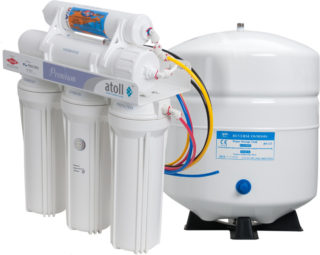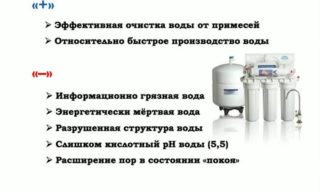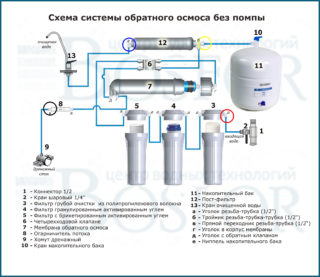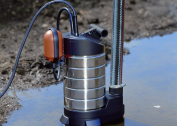The reverse osmosis technology was used in ancient Greece, and the Greeks borrowed it from the Egyptians. People used membrane filters to desalinate sea salt water. The degree of purification was not very high, but it was possible to get drinking water. With the advent of new materials, removing various salts has become easier. Warning for buyers: do not trust street managers who offer very favorable conditions for reverse osmosis filters for a house of unknown origin. A quality product can only be purchased from trusted manufacturers, and their price will not be low.
Purpose and scope

Reverse osmosis systems are used in areas where it is very important to use the highest quality water - medicine, food industry, restaurants and other catering establishments. In pharmacology and the chemical industry, it is extremely important that the liquid does not contain viruses, bacteria, as well as dissolved salts of calcium, magnesium, sodium. Most often, such enterprises use distilled water for the manufacture of medicines.
The installation of a filter with a reverse osmosis system is intended for the complete purification of tap water, which, in addition to chlorine compounds, contains large pieces of rust, sand, organics, as well as various bacteria that can cause illness in humans. There were cases when, after using unboiled tap water, people became ill with hepatitis, became infected with intestinal infections, parasites, and even meningitis. In ancient times, the installation of a simple sand filter made it possible to protect during the cholera epidemic.
It is better to fill in distilled water in home autonomous heating systems, as this extends the life of pipes and radiators. It is especially important to protect the pipes for floor heating, since repairing highways poured into concrete is not an easy task and is expensive.
There is a medical point of view on the use of water in which dissolved salts are completely absent. Minerals play a role in the processes of the body. Their absence can cause impaired functioning of the cardiovascular and nervous systems, kidneys, and impair hematopoietic function. For this, multistage water treatment systems were created, including mineralizers, which return a certain amount of mineral substances necessary for a person to liquid.
The principle of operation and design of a reverse osmosis system
 Five-stage water purification systems are popular. The main component is a synthetic semipermeable membrane consisting of hollow fibers. The pore diameter is very small, capable of transmitting only water molecules. Various organics, microorganisms and other debris remain on the surface of the membrane and then washed off into the sewer.
Five-stage water purification systems are popular. The main component is a synthetic semipermeable membrane consisting of hollow fibers. The pore diameter is very small, capable of transmitting only water molecules. Various organics, microorganisms and other debris remain on the surface of the membrane and then washed off into the sewer.
The system operates at a certain pressure in the water supply. In an apartment, it is from 2 to 6 atmospheres. Water needs to be forced through pores. Some filters use a different method - a low pressure area (vacuum) is created on the reverse side and the liquid itself is absorbed through the membrane. Next is the storage tank, where the purified liquid is drained.
There are other elements in five-stage reverse osmosis filters:
- a pre-filter that traps large debris, such as sand or rust;
- carbon filter, where chemicals and organic impurities leave the liquid;
- the next element of the system delays suspended mechanical particles whose diameter is not more than 1 micron.
All three filters prepare water before thin cleaning through the membrane. The system can do without a hydraulic accumulator, but better when it is. A hydraulic tank is a metal casing with a rubber bulb inside it. It is made of food rubber and does not transfer harmful substances into the liquid. Such containers are used in the design of pumping stations and are intended exclusively for the storage of drinking water.
In high-rise buildings, where there is an interruption in pressure, especially at rush hour, it is necessary to install a pump that maintains pressure when installing the filter, otherwise the operation of the system will be ineffective.
There are domestic and industrial installations. They differ primarily in performance (how many liters of fluid can be obtained per unit of time).
Particular attention should be paid to the quality of the materials of which the membrane is made. It depends on how much time it can serve without replacement. On sale you can find cheap options from synthetic materials.
Ceramic membranes serve more than 10 years, self-clean under the influence of a stream of water and do not require replacement. In extreme cases, you can use a kitchen sponge and soda to wash away the pollution that begins to form a month after the start of using the system.
Specifications
Filter life from 4 to 15 thousand liters. The system can dispense from 150 to 250 liters of drinking water per day. For a family of 3 people, a filter is enough, the resource of which is 5 thousand liters. This is enough for 2 to 3 years. At the same time, once every 6 months, the cartridges in the preliminary filters are changed, and once a year - the membranes. The frequency of replacement also depends on the material of the membrane. If you do not save on the cost of the system, it will be cheaper to maintain it.
Industrial filters have a much greater resource, but they cost accordingly more.
Pros and cons of reverse osmosis filters
 The advantages of reverse osmosis filtration include:
The advantages of reverse osmosis filtration include:
- High degree of purification - up to 98%. The quality of the resulting liquid is similar to melt water.
- All harmful substances are removed - the remains of chemical fertilizers, poisons like arsenic, heavy metals.
- You can choose a model depending on the needs of the family.
- Russian manufacturers produce filters based on the degree of pollution of tap water. In this case, it is better to buy domestic products, as they are more adapted to local conditions. Imported models require frequent cartridge replacement.
- Simple installation of the system - you can do it yourself.
Of the disadvantages:
- High prices for household reverse osmosis water filters.
- ¾ liquids will drain into the sewer along with contamination.
- To restore the lost salt you need to install a mineralizer.
- Additionally, you need to buy a tap for clean water, it is not included.
- Slow cleaning speed.
- The need to replace pre-cleaning cartridges - if this is not done, the membrane will quickly clog.
- The reverse osmosis filter is not connected to a hot water supply.
Despite a rather large list of disadvantages and costs, using a filter is more profitable than buying drinking water daily in stores.
Criterias of choice
The main criterion for choosing water filters for most people is the price. The more cleaning steps and the higher the recovery possibilities after the final filtration, the more expensive the system.
In order not to overpay, it is necessary to calculate the approximate consumption of drinking water per family. Perhaps it is better to put a seven-stage filter system, but lower performance.
A storage tank is a time saver. It is filled as long as the air pressure outside the pear allows.Then it will gradually give liquid to the tap.
The difference between expensive and cheap models is the quality of the membrane and its service life. Cheap swell faster and cease to fulfill their functions.
Installation and operation
 To install and connect household models, you need a minimum set of tools and instructions attached to the product. The main task is to embed the system in the water supply and install a tap for drinking water. This is done with flexible hoses and connectors. If the filter was purchased in a specialized store, you can invite the wizard to install the system in the apartment.
To install and connect household models, you need a minimum set of tools and instructions attached to the product. The main task is to embed the system in the water supply and install a tap for drinking water. This is done with flexible hoses and connectors. If the filter was purchased in a specialized store, you can invite the wizard to install the system in the apartment.
Maintenance of filters of the reverse osmosis system consists in the timely replacement of cartridges. It is necessary to study the instructions well to know when which filter needs to be checked. Each cartridge changes at different times - for some, the deadline occurs every three months, others change in a year or two. This procedure can be carried out independently.
The main condition for continuous operation is constant pressure in the water supply. If there are interruptions, it is better to immediately install a pump that will maintain the necessary mode of operation. With insufficient pressure, the membrane quickly silts and does not work.
Problems in the system must be able to recognize. For example, scale will appear in the kettle, although before that it was not there, or the sound of water escaping into the sewer will be heard. Outages in the pump also indicate the need to check the system and replace cartridges.
If you calculate the cost of replacing the cartridges, they are about 50% per year of the total cost of the filter, the price of which ranges from 10 to 15 thousand rubles. It should be borne in mind that water savings will be about 60% per liter, not taking into account the time spent on shopping.


